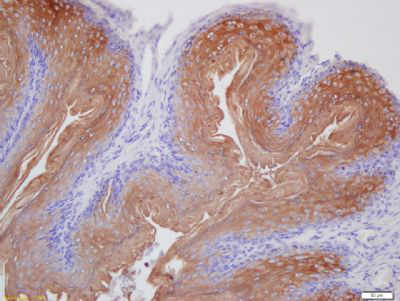产品货号 : mlR6713
英文名称 : Laminin 5
中文名称 : 层粘连蛋白5抗体
别 名 : E170; Epiligrin 170 kDa subunit; Epiligrin subunit alpha; Kalinin subunit alpha; LAMA3; LAMA3A; Laminin 5 alpha3; Laminin A3; laminin alpha 3; laminin alpha3; Laminin subunit alpha-3; Laminin-5 subunit alpha; Laminin-6 subunit alpha; Laminin-7 subunit alpha; laminin5 alpha 3; Laminin5 alpha3; LAMNA; LOCS; Nicein subunit alpha; LAMA3_HUMAN.
研究领域 : 肿瘤 心血管 细胞生物 免疫学 神经生物学 信号转导 细胞粘附分子 细胞骨架 细胞外基质
抗体来源 : Rabbit
克隆类型 : Polyclonal
交叉反应 : Human, Mouse, Rat, Dog, Pig, Cow, Horse, Rabbit,
产品应用 : ELISA=1:500-1000 IHC-P=1:400-800 IHC-F=1:400-800 IF=1:100-500 (石蜡切片需做抗原修复)
not yet tested in other applications.
optimal dilutions/concentrations should be determined by the end user.
分 子 量 : 367kDa
细胞定位 : 细胞膜 细胞外基质 分泌型蛋白
性 状 : Lyophilized or Liquid
浓 度 : 1mg/ml
免 疫 原 : KLH conjugated synthetic peptide derived from human Laminin 5:2701-2900/3333
亚 型 : IgG
纯化方法 : affinity purified by Protein A
储 存 液 : 0.01M TBS(pH7.4) with 1% BSA, 0.03% Proclin300 and 50% Glycerol.
保存条件 : Store at -20 °C for one year. Avoid repeated freeze/thaw cycles. The lyophilized antibody is stable at room temperature for at least one month and for greater than a year when kept at -20°C. When reconstituted in sterile pH 7.4 0.01M PBS or diluent of antibody the antibody is stable for at least two weeks at 2-4 °C.
PubMed : PubMed
产品介绍background:
Binding to cells via a high affinity receptor, laminin is thought to mediate the attachment, migration and organization of cells into tissues during embryonic development by interacting with other extracellular matrix components. Laminin-5 is thought to be involved in (1) cell adhesion via integrin alpha-3/beta-1 in focal adhesion and integrin alpha-6/beta-4 in hemidesmosomes, (2) signal transduction via tyrosine phosphorylation of pp125-FAK and p80, (3) differentiation of keratinocytes.
Tissue specificity; Skin; respiratory, urinary, and digestive epithelia and in other specialized tissues with prominent secretory or protective functions. Epithelial basement membrane, and epithelial cell tongue that migrates into a wound bed. A differential and focal expression of the subunit alpha-3 is observed in the CNS.
Function:
Binding to cells via a high affinity receptor, laminin is thought to mediate the attachment, migration and organization of cells into tissues during embryonic development by interacting with other extracellular matrix components.
Laminin-5 is thought to be involved in (1) cell adhesion via integrin alpha-3/beta-1 in focal adhesion and integrin alpha-6/beta-4 in hemidesmosomes, (2) signal transduction via tyrosine phosphorylation of pp125-FAK and p80, (3) differentiation of keratinocytes.
Subunit:
Laminin is a complex glycoprotein, consisting of three different polypeptide chains (alpha, beta, gamma), which are bound to each other by disulfide bonds into a cross-shaped molecule comprising one long and three short arms with globules at each end. Alpha-3 is a subunit of laminin-5 (laminin-332 or epiligrin/kalinin/nicein), laminin-6 (laminin-311 or K-laminin) and laminin-7 (laminin-321 or KS-laminin).
Subcellular Location:
Secreted, extracellular space, extracellular matrix, basement membrane.
Tissue Specificity:
Skin; respiratory, urinary, and digestive epithelia and in other specialized tissues with prominent secretory or protective functions. Epithelial basement membrane, and epithelial cell tongue that migrates into a wound bed. A differential and focal expression of the subunit alpha-3 is observed in the CNS.
DISEASE:
Defects in LAMA3 are a cause of epidermolysis bullosa junctional Herlitz type (H-JEB) [MIM:226700]; also known as junctional epidermolysis bullosa Herlitz-Pearson type. JEB defines a group of blistering skin diseases characterized by tissue separation which occurs within the dermo-epidermal basement membrane. H-JEB is a severe, infantile and lethal form. Death occurs usually within the first six months of life. Occasionally, children survive to teens. H-JEB is marked by bullous lesions at birth and extensive denudation of skin and mucous membranes that may be hemorrhagic.
Defects in LAMA3 are the cause of laryngoonychocutaneous syndrome (LOCS) [MIM:245660]. LOCS is an autosomal recessive epithelial disorder confined to the Punjabi Muslim population. The condition is characterized by cutaneous erosions, nail dystrophy and exuberant vascular granulation tissue in certain epithelia, especially conjunctiva and larynx.
Similarity:
Contains 15 laminin EGF-like domains.
Contains 5 laminin G-like domains.
Contains 1 laminin IV type A domain.
Contains 1 laminin N-terminal domain.
SWISS:
Q16787
Gene ID:
3909
Important Note:
This product as supplied is intended for research use only, not for use in human, therapeutic or diagnostic applications.
产品图片












